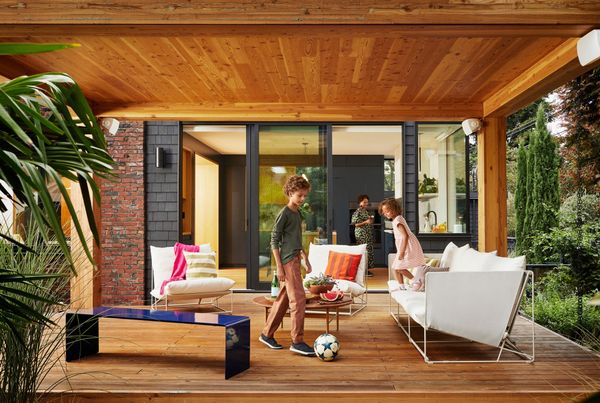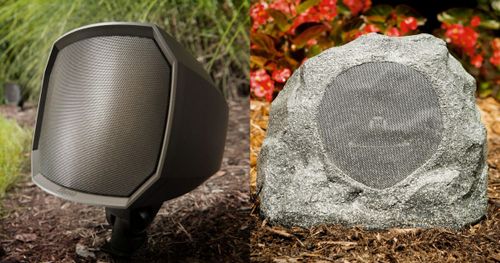
At A Glance:
Why Outdoor Environments Demand Special Speakers
The Core Features Every Outdoor Speaker Must Have
Placement and Installation: Maximizing Performance
How to Choose Outdoor Speakers That Fit Your Space and Style
Tips for First-Time Buyers (and Audio Veterans Alike)
Bringing Music to Your Outdoor Living Space
Transforming your backyard, patio, or pool area into a lively, welcoming hub often starts with one vital upgrade: great sound. Music can set the mood for evening BBQs, liven up family gatherings, or simply provide a personalized ambiance as you unwind outside. But choosing the right outdoor speakers isn’t as simple as picking any speaker and setting it outside. The environment, elements, and acoustics of outdoor spaces all influence how sound will travel—and how long your investment will last.
With so many options, features, and marketing claims, what to look for when buying outdoor speakers can feel overwhelming, even for experienced audio fans. This comprehensive outdoor speaker buying guide will walk you through exactly what matters—from weatherproof speakers and sound quality to placement and system compatibility—so you can enjoy lasting, reliable, and impressive audio across your favorite outdoor spaces.
Transform Your Backyard Space with Outdoor Audio
Enhance your outdoor space with the best audio from Paradyme. With weatherproof speaker options and expert placement, the team at Paradyme can deliver perfect sound for any outdoor area.
Outdoor Entertainment AreaWhy Outdoor Environments Demand Special Speakers

The Challenge of the Great Outdoors
Unlike enclosed living rooms or dens, outdoor areas present several unique challenges for audio. There are no walls or ceilings to reflect and focus sound, which means music can quickly “disappear” into open air. Weather is unpredictable—speakers must survive sun, rain, wind, freezing temperatures, and even occasional pests. On top of that, outdoor sounds (neighbors, traffic, birds, leaf blowers) can mask your music if your equipment isn’t up to the task.
That’s why indoor speakers—even high-end ones—aren’t built for patios, decks, or gardens. Enter outdoor speakers, purpose-designed to bring reliable audio performance, wider sound coverage, and resilience to the elements—all without sacrificing musical clarity.
Learn more: Outdoor Audio: Are Rock Speakers The Right Choice?
The Core Features Every Outdoor Speaker Must Have

1. Weather Resistance and Durability
Arguably the most crucial feature, weather resistance defines the difference between true outdoor speakers and those that may fail at the first sign of rain. Look for products labeled as “weatherproof,” “all-weather,” or specifically as weather resistance outdoor speakers. But what does this actually mean?
True weather resistance includes:
- Sealed enclosures to prevent water, dust, and insects from entering and damaging internal components.
- UV-resistant housings that prevent fading and cracking due to sun exposure.
- Rustproof grilles and hardware to withstand humidity, salty air (if you live near the coast), and precipitation.
- Temperature-tolerant electronics capable of functioning in both hot summers and cold winters.
What to Look For
- IP Ratings: The Ingress Protection (IP) rating indicates a device’s resistance to dust and water. An IPX4 rating or higher is recommended for speakers that may get wet. For poolside installation, look for IPX6 or better.
- Material Quality: Enclosures made from composites, marine-grade plastics, or heavy-duty aluminum last longer than untreated wood or basic plastic.
2. Sound Quality and Coverage
All outdoor speakers are not created equal in the sound department. Outside, achieving crisp, full-range sound requires thoughtful design—especially since you can’t rely on walls to reinforce bass or focus treble.
Key Considerations
- Speaker Size: Larger drivers generally move more air and deliver deeper bass—especially important in open areas where low-end frequencies can dissipate quickly. Look for at least 5.25-inch woofers for broad coverage; larger spaces benefit from 6.5-inch or 8-inch drivers.
- Dispersion (Coverage) Angle: This tells you how wide the sound spreads. Wide-dispersion speakers offer more coverage from a single location; directional models are best for targeting sound to certain zones.
- Power Handling: Measured in watts (W), this determines how “loud” and “clean” your speakers can play without distortion. Pair the speaker’s recommended power with your amplifier for best results.
Evaluating Sound Quality
- Frequency Response: Good outdoor speakers should reproduce lows, mids, and highs with clarity. A published frequency response (e.g., 60Hz–20kHz) signals versatility.
- Sensitivity: Measured in decibels (dB), higher sensitivity speakers need less power to play loudly and work well with most receivers or amps.
- Listening Area: Larger backyards need more volume and/or more speakers than a small patio—consider sound “zones” for balanced audio across your space.
Placement and Installation: Maximizing Performance

3. Where and How to Position Your Outdoor Speakers
Placement makes a night-and-day difference in your outdoor listening experience. Good positioning can mean the difference between immersive surround sound and “echoes” lost to the wind.
General Guidelines:
- Mounting Height: Install speakers 8 to 10 feet above the ground for optimal sound dispersion, angling them down toward the listening area.
- Facing the Listeners: Point speakers toward your main entertaining spaces, such as a patio, deck, or pool lounging area. Avoid facing speakers directly at neighbors or open spaces, which can dissipate sound.
- Left and Right Channels: For stereo sound, mount pairs at least 8 to 10 feet apart. If using a single speaker for smaller areas, look for dual-voice-coil designs that deliver both left and right channels.
Creative Options:
- Rock or Planter Speakers: Designed to blend into natural landscaping, these options work well for garden paths or inconspicuous sound near flowerbeds.
- In-Ground and Bollard Speakers: These provide 360-degree sound—perfect for large areas without mounting options.
4. Wired vs. Wireless Outdoor Speakers
Today’s market offers both wired and wireless outdoor speakers, each with distinct advantages and considerations.
Wired Outdoor Speakers
- Advantages:
- Typically provide better fidelity and full-range sound.
- Reliable signal—no dropouts or interference from Wi-Fi congestion.
- Compatible with whole-house or multi-zone audio systems.
- Draw power directly from amplifier/receiver.
- Considerations:
- Professional installation (or confident DIY) often required for safe wiring runs.
- Planning for cable management, trenching, or conduit for a cleaner look.
- Permanent placement—may be less flexible for future changes.
Wireless Outdoor Speakers
- Advantages:
- Simple placement—they’re portable and easy to move.
- Bluetooth or Wi-Fi models allow flexible, on-demand listening.
- Rechargeable battery models avoid any cabling.
- Considerations:
- Typically, less power and sometimes less bass than similarly priced wired models.
- Can suffer interference from other wireless devices or limited range.
- Battery-powered speakers require regular charging (consider battery life for long parties).
5. Compatibility with Your Outdoor Audio System
Your speakers need to work seamlessly with your existing (or planned) outdoor audio system. Before purchasing, check:
- Amplifier/Receiver Requirements: Impedance rating (measured in ohms), power recommendations, and connection types. Most outdoor models are 8-ohm and pair well with standard home receivers.
- Streaming Sources: Will you be using smart home hubs, Bluetooth from your phone, or a proprietary multi-room platform? Some outdoor speakers work with Sonos, HEOS, or AirPlay for full wireless integration.
- Speaker Zones: Multi-zone amplifiers let you independently adjust the volume for different parts of your yard—essential for balancing poolside energy with quiet dining areas.
Learn more: Your Guide to In-Wall Surround Sound Systems for Modern Home Theaters
How to Choose Outdoor Speakers That Fit Your Space and Style

Size, Shape, and Aesthetics
How to choose outdoor speakers often comes down to matching the speaker’s visual presence with your landscape and decor preferences.
- Wall-Mounted: Best for patios, decks, and under eaves—keep them off the ground and out of the way.
- Landscape (In-Ground, Rock, Planter): Ideal when you want speakers to disappear into your garden or foliage.
- Bollard or Stake Speakers: Perfect for open lawns or along pathways, providing near 360-degree coverage.
- Portable Speakers: Great for renters or environments where permanent installation isn’t an option.
Pro Tip: Many top brands offer speakers in multiple colors or with paintable cabinets, so you can match your surroundings.
Determining the Right Number and Placement
- Small Patios or Balconies: One or two speakers, mounted to cover the main seating area, typically suffice.
- Medium Decks/Yards: Two pairs in opposite corners, angled inward, create balanced coverage.
- Large Yards/Pool Areas: Multiple speakers in zones, and possibly a weather-resistant outdoor subwoofer for bass.
The goal: achieve full, even sound that doesn’t require cranking the volume to reach distant zones.
Matching Speaker Power to Your Space
A common buying mistake is underpowering your space—forcing a small pair of speakers to cover a sprawling backyard leads to distortion, or overly loud areas close to the speakers. Always size up slightly, using more speakers at lower volume for balanced, immersive sound.
Example: For a medium-sized yard, four speakers spaced around the perimeter, with each playing at a moderate level, creates a rich, enveloping sound without blasting guests in one area or missing others.
Tips for First-Time Buyers (and Audio Veterans Alike)

- Test the Sound When Possible: If you’re shopping in a store, ask for a demo, or read in-depth reviews from trusted reviewers.
- Look for Warranties: Long warranties and strong manufacturer reputations suggest both quality and resilience.
- Check Installation Guides: Good outdoor speakers come with clear instructions—look for mounting hardware, templates, or support for custom installs.
- Think About Expansion: If you might want to add zones, subwoofers, or more speakers in the future, ensure your amp and wiring can accommodate growth.
- Consider Smart Features: If you use smart home systems for lighting, security, or climate—a speaker that plays nicely with Alexa, Google Assistant, or Apple HomeKit adds bonus convenience.
How to Maintain Outdoor Speakers for Longer Life
- Seasonal Cleaning: Wipe down enclosures and grilles every month or so to prevent build-up of dust or debris.
- Inspect for Wear: Check cabling, seals, and mounts after storms or each season for early signs of wear.
- Winter Protection: If you live in an area with severe winters, consider removable grilles, bring portable speakers inside, or invest in custom covers.
- Secure Mounting: Ensure all brackets and mounts are tight and rust-free—wind and weather can loosen hardware over time.
Learn more: The Complete Guide to 2 Way vs 3 Way Speakers
Bringing Music to Your Outdoor Living Space

Choosing the best outdoor speakers for your yard, patio, or pool isn’t just about ticking boxes for power and protection—it’s about delivering a soundtrack for your outdoor life. By prioritizing weather resistance, sound performance, thoughtful placement, and style, you’re investing in many seasons (and reasons) to gather, relax, and celebrate outdoors.
Whether you’re installing your first speakers or leveling up your entire outdoor audio system, use this outdoor speaker buying guide to make an informed choice. The right speakers will turn every cookout, pool party, or quiet morning coffee into a memorable event, with music (and quality) that lasts. So consider your space, listen carefully, and get ready to amplify your backyard fun with Paradyme—for years to come.
FAQ: Outdoor Speaker Buying Guide
When purchasing outdoor speakers, focus on true weather resistance (IP rating, sealed housing), suitable sound coverage for your space, and durable build quality. Make sure they’re compatible with your amp or receiver, and pick a style that suits your landscape.
High-quality outdoor speakers offer clear, detailed audio across all frequencies, solid bass (even outdoors), and are built with durable materials. Look for reviews, warranties, and well-respected brand reputations. Testing before purchase is ideal, or rely on trusted third-party reviews.
Wireless outdoor speakers have improved significantly but may not match the power, sound quality, or consistency of mid- to high-end wired models, especially for large spaces or demanding audio use. For convenience and flexibility, wireless shines; for uncompromising music lovers, wired is still king.
It depends on your comfort level with wiring, mounting, and system setup. Basic installations are DIY-friendly, especially for wireless and plug-and-play models. Complex setups, buried cabling, or integrated systems may be best handled by a professional installer to ensure safety, performance, and longevity.
Why Trust Paradyme?
Since 1976, our Sacramento business has served the northern California region with unparalleled expertise in Hi-Fi systems, TVs, and car audio. With unparalleled expertise, Paradyme progresses the way forward in modern-day solutions. We foster a strong culture of innovation and knowledge to meet our residential and commercial customers' tech needs with state-of-the-art capabilities that remain unrivaled. Our unbeatable reputation speaks volumes about delivering only the best!
Our team of experts has years of experience and industry knowledge under their belt to provide exclusive, luxury-level service in custom electronics for our customers throughout Sacramento and northern California.
Shop Smart Solutions at Paradyme
At Paradyme, we provide quality top-of-the-line brands for every project. We have experienced technicians who know the right way to install smart home products, car audio and video solutions, home theater options, and much more. Give us a call at 916-481-3900 or stop by today.